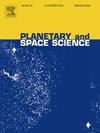基于“天文一号”MoRIC图像不平衡数据集的火星陨坑形态自动分类
IF 1.7
4区 物理与天体物理
Q3 ASTRONOMY & ASTROPHYSICS
引用次数: 0
摘要
火星的撞击坑包含丰富的地貌信息;它们的类型是反映天体地质演化和年代学的重要指标。目前,目视检查是识别陨石坑类型及其形态特征最常用和被广泛接受的方法。然而,这是一项主观任务,需要专业知识。在这项工作中,我们提出了一种利用不平衡火星图像数据集对火星陨石坑进行自动形态分类的方法。具体而言,我们基于罗宾斯陨石坑目录,根据陨石坑形态特征对“天文一号”的MoRIC图像进行分类和裁剪;利用这些图像建立了六种不同类型的火星撞击坑的数据集。在此数据集的基础上,我们使用CNN和Transformer架构的三种流行的神经网络模型对火星陨石坑进行分类。同时,针对行星遥感数据集在网络训练过程中常见的样本不平衡问题,我们引入了标签平滑策略和加权损失函数两种方法来抑制其对分类精度的影响。实验结果表明,视觉变压器(Vision Transformer, ViT)模型具有最高的分类准确率,达到90.3%。标签平滑策略在CNN方法中表现良好,其中VGGNet11将准确率提高了2.2%。相比之下,加权损失函数在ViT中表现良好,ViT的分类准确率提高了1.3%。这些结果表明,应用深度神经网络自动识别和形态分析火星陨石坑具有广阔的前景。本文章由计算机程序翻译,如有差异,请以英文原文为准。
Automatic morphologic classification of Martian craters using imbalanced datasets of Tianwen-1’s MoRIC images with deep neural networks
Martian impact craters contain prolific geomorphic information; their types provide vital indicators reflecting the geological evolution and chronology of celestial bodies. Currently, visual inspection is the most commonly used and widely accepted approach for identifying the crater types and their morphological features. However, it is a subjective task and requires professional knowledge. In this work, we present a method for the automatic morphologic classification of Martian craters using imbalanced Mars image datasets. Specifically, we classified and cropped Tianwen-1’s MoRIC images according to the morphological features of craters based on Robbins’ impact crater catalog; a dataset of six different types of Mars impact craters was established using the images. Based on this dataset, we classified the Mars impact craters using three popular neural network models with CNN and Transformer architectures. Meanwhile, to address the imbalanced samples in the network training process, a common problem in planetary remote sensing datasets, we introduce two methods (i.e., label smoothing strategy and weighted loss function) to suppress its influence on classification accuracy. Experimental results show that the Vision Transformer (ViT) model has the highest classification accuracy, reaching 90.3%. The label smoothing strategy performs well in CNN approaches, among which VGGNet11 improves the accuracy by 2.2%. By contrast, the weighted loss function performs well in ViT, and the classification accuracy of ViT improves by 1.3%. These results demonstrate a promising future for applying deep neural networks to identify and morphologically analyze Martian craters automatically.
求助全文
通过发布文献求助,成功后即可免费获取论文全文。
去求助
来源期刊

Planetary and Space Science
地学天文-天文与天体物理
CiteScore
5.40
自引率
4.20%
发文量
126
审稿时长
15 weeks
期刊介绍:
Planetary and Space Science publishes original articles as well as short communications (letters). Ground-based and space-borne instrumentation and laboratory simulation of solar system processes are included. The following fields of planetary and solar system research are covered:
• Celestial mechanics, including dynamical evolution of the solar system, gravitational captures and resonances, relativistic effects, tracking and dynamics
• Cosmochemistry and origin, including all aspects of the formation and initial physical and chemical evolution of the solar system
• Terrestrial planets and satellites, including the physics of the interiors, geology and morphology of the surfaces, tectonics, mineralogy and dating
• Outer planets and satellites, including formation and evolution, remote sensing at all wavelengths and in situ measurements
• Planetary atmospheres, including formation and evolution, circulation and meteorology, boundary layers, remote sensing and laboratory simulation
• Planetary magnetospheres and ionospheres, including origin of magnetic fields, magnetospheric plasma and radiation belts, and their interaction with the sun, the solar wind and satellites
• Small bodies, dust and rings, including asteroids, comets and zodiacal light and their interaction with the solar radiation and the solar wind
• Exobiology, including origin of life, detection of planetary ecosystems and pre-biological phenomena in the solar system and laboratory simulations
• Extrasolar systems, including the detection and/or the detectability of exoplanets and planetary systems, their formation and evolution, the physical and chemical properties of the exoplanets
• History of planetary and space research
 求助内容:
求助内容: 应助结果提醒方式:
应助结果提醒方式:


